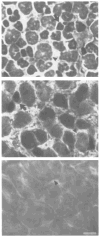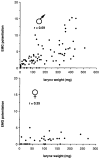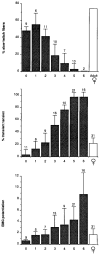Development of functional sex differences in the larynx of Xenopus laevis
- PMID: 1879611
- PMCID: PMC3493208
- DOI: 10.1016/s0012-1606(05)80022-3
Development of functional sex differences in the larynx of Xenopus laevis
Abstract
Three laryngeal properties associated with the production of masculine song--laryngeal muscle tension, fiber twitch type, and fiber recruitment--are markedly sexually dimorphic in adult Xenopus laevis frogs. To elucidate the pattern of sexual differentiation, tension and fiber recruitment in male and female larynges and fiber twitch type in male larynges were examined throughout postmetamorphic development. Masculinization of male laryngeal properties begins early in postmetamorphic development and continues until adulthood. In contrast, tension and fiber recruitment in females do not change after the end of metamorphosis. Laryngeal muscle tension and fiber type are gradually and progressively masculinized; the temporal pattern of masculinization is very similar for these properties. Fiber recruitment, on the other hand, appears to masculinize in a stepwise manner. Masculinization of all three properties is highly correlated with larynx weight in males. We have used this relation to divide postmetamorphic development into seven stages associated with key events in sexual differentiation. This staging scheme provides an important experimental tool for studying the hormonal regulation of sexual differentiation, the subject of the accompanying paper.
Figures








Similar articles
-
Temporal constraints on androgen directed laryngeal masculinization in Xenopus laevis.Dev Biol. 1991 Sep;147(1):260-70. doi: 10.1016/s0012-1606(05)80023-5. Dev Biol. 1991. PMID: 1879612 Free PMC article.
-
The sexually dimorphic larynx of Xenopus laevis: development and androgen regulation.Am J Anat. 1986 Dec;177(4):457-72. doi: 10.1002/aja.1001770404. Am J Anat. 1986. PMID: 3812330
-
The roles of sex, innervation, and androgen in laryngeal muscle of Xenopus laevis.J Neurosci. 1993 Jan;13(1):324-33. doi: 10.1523/JNEUROSCI.13-01-00324.1993. J Neurosci. 1993. PMID: 8423478 Free PMC article.
-
Neuroeffectors for vocalization in Xenopus laevis: hormonal regulation of sexual dimorphism.J Neurobiol. 1986 May;17(3):231-48. doi: 10.1002/neu.480170307. J Neurobiol. 1986. PMID: 3519865 Review.
-
A Tutorial of the Effects of Sex Hormones on Laryngeal Senescence and Neuromuscular Response to Exercise.J Speech Lang Hear Res. 2019 Mar 25;62(3):602-610. doi: 10.1044/2018_JSLHR-S-18-0179. J Speech Lang Hear Res. 2019. PMID: 30950744 Free PMC article. Review.
Cited by
-
Testicular masculinization of vocal behavior in juvenile female Xenopus laevis reveals sensitive periods for song duration, rate, and frequency spectra.J Comp Physiol A. 1992 Oct;171(3):343-50. doi: 10.1007/BF00223964. J Comp Physiol A. 1992. PMID: 1447723
-
Sexually differentiated, androgen-regulated, larynx-specific myosin heavy-chain isoforms in Xenopus tropicalis; comparison to Xenopus laevis.Dev Genes Evol. 2008 Jul;218(7):371-9. doi: 10.1007/s00427-008-0223-2. Epub 2008 Jun 13. Dev Genes Evol. 2008. PMID: 18551305 Free PMC article.
-
Deconstructing cartilage shape and size into contributions from embryogenesis, metamorphosis, and tadpole and frog growth.J Anat. 2015 Jun;226(6):575-95. doi: 10.1111/joa.12303. Epub 2015 Apr 25. J Anat. 2015. PMID: 25913729 Free PMC article.
-
Sexually dimorphic expression of a laryngeal-specific, androgen-regulated myosin heavy chain gene during Xenopus laevis development.Dev Biol. 1992 Dec;154(2):366-76. doi: 10.1016/0012-1606(92)90075-r. Dev Biol. 1992. PMID: 1426643 Free PMC article.
-
A sex difference in synaptic efficacy at the laryngeal neuromuscular junction of Xenopus laevis.J Neurosci. 1995 Mar;15(3 Pt 1):1660-8. doi: 10.1523/JNEUROSCI.15-03-01660.1995. J Neurosci. 1995. PMID: 7891126 Free PMC article.
References
-
- Burke R. Motor units: Physiological/histochemical profiles, neuronal connectivity and functional specializations. Am Zool. 1978;18:127–134.
-
- Guth L, Samaha F. Procedure for histochemical demonstration of actomyosin ATPase. Exp Neurol. 1970;28:365–367. - PubMed
-
- Hannigan P, Kelley D. Androgen-induced alterations in vocalizations of female Xenopus laevis: Modiflability and constraints. J Comp Physiol A. 1986;158:517–528. - PubMed
-
- Kelley D. Sexually dimorphic behavior. Ann Rev Neurosci. 1988;11:225–251. - PubMed
-
- Kelley D, Tobias M. The genesis of courtship song: Cellular and molecular control of a sexually differentiated behavior. In: Carew TJ, Kelley DB, editors. Perspectives in Neural Systems and Behavior. A. R. Liss; New York: 1989. pp. 175–194.
Publication types
MeSH terms
Grants and funding
LinkOut - more resources
Full Text Sources

